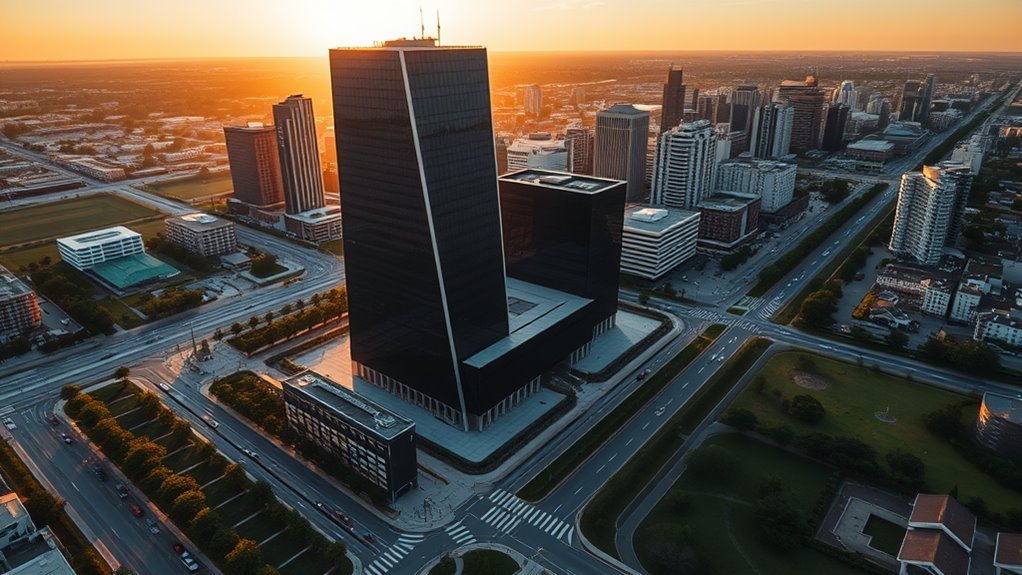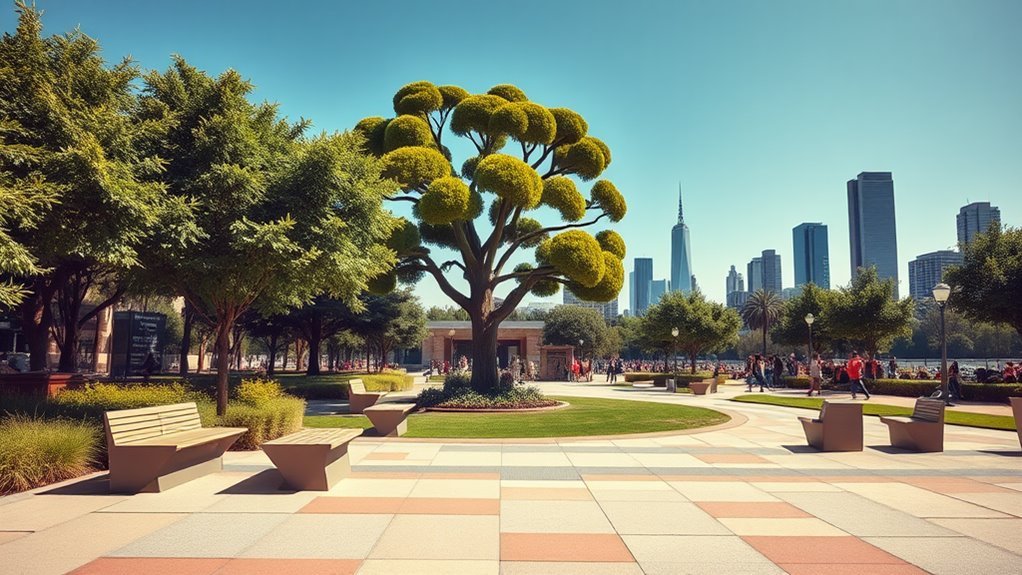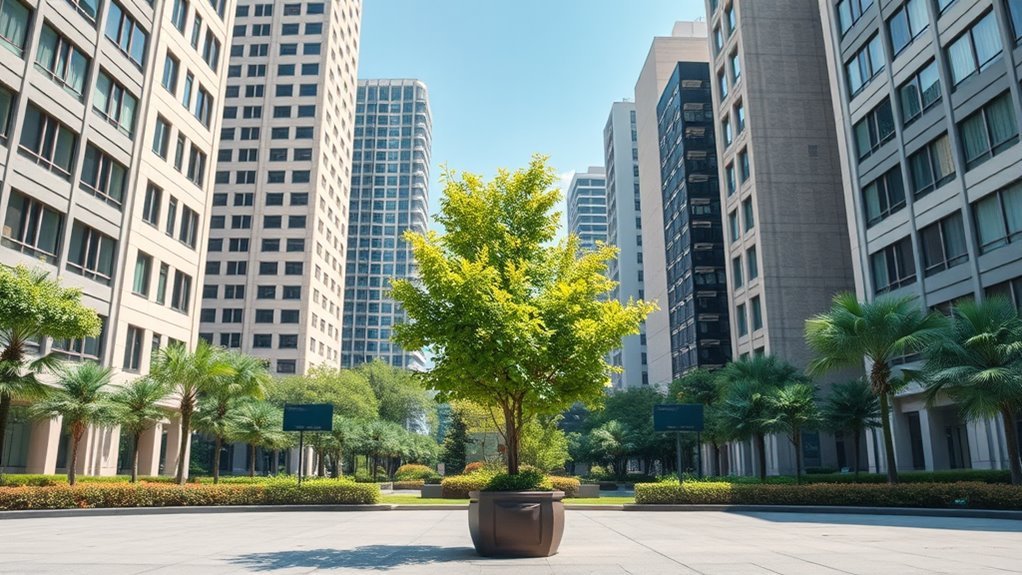Urbanization brings a mixed bag of excitement and challenges. On the bright side, cities offer great jobs, diverse services, and access to technology, which can boost innovation. Nevertheless, with all this growth comes increased pollution, heavy traffic, and rising living costs. Many people struggle with high rents and crowded spaces, which can hurt mental health and wildlife. It’s a balancing act – can cities grow sustainably? Stick around to investigate the ins and outs of urban life!
Main Points
- Urbanization offers increased job opportunities and higher wages, making cities attractive for job seekers and fostering innovation.
- High living costs and limited affordable housing in urban areas exacerbate social inequality and push low-income residents into informal settlements.
- Urban areas face significant environmental challenges, including pollution, resource strain, and loss of biodiversity due to rapid growth.
- Access to healthcare, education, and social services improves in cities, enhancing quality of life and community engagement.
- Urban life can lead to higher mental health issues, stress, crowded environments, and financial pressures.
Is Urbanization Sustainable Long-Term?
Is urbanization truly sustainable in the long run? The answer isn’t so simple. Urban areas can become bustling hubs of activity, but they often come with a price. Increased pollution levels and inadequate public services can make life tough for residents.
Imagine living in a city where trash piles up and public transportation is unreliable; not exactly a dream come true! For urbanization to be sustainable, cities must invest in green infrastructure and efficient public services.
Balancing economic growth with environmental protection is key. If cities don’t prioritize affordable housing and inclusive policies, social inequality could worsen.
It’s a tricky dance, but with the right steps, urbanization might just keep the rhythm going for generations to come.
Pro #1. Increased Access to Services
Cities aren’t just about tall buildings and busy streets; they also serve as gateways to a wealth of services that can make life easier and more fulfilling.
One of the biggest perks of urban living is the incredible access to services. In cities, residents find an abundance of healthcare options, with hospitals and clinics just around the corner, leading to better health outcomes.
Education thrives here too, with more schools and resources, boosting literacy rates for everyone. Plus, urban areas boast a variety of social services that tackle important community needs.
The plethora of businesses means choices galore for shopping and dining, all contributing to a higher quality of life. With efficient transportation, getting to these services is a breeze, making city life even more appealing!
Con #1. Increased Pollution Levels
While urban living offers many perks, it also comes with a hefty price tag in the form of pollution. Cities are like giant magnets for pollution, cranking out about 70% of the world’s carbon dioxide emissions, thanks to all those cars and factories.
Urban residents often find themselves surrounded by noise levels that can hit 85 decibels, which is loud enough to make anyone’s head spin!
Water pollution is another issue, with nasty runoff from streets poisoning local waterways. Plus, urban heat islands make cities hotter, leading to more energy use and air pollution.
Combine that with poor waste management, and it’s clear that urbanization can turn vibrant cities into pollution hotspots.
It’s a tough trade-off for those chasing city life.
Pro #2. Job Creation Opportunities

Urban areas are like treasure chests when it comes to job opportunities, bursting with a variety of options for those keen to plunge into the workforce. Cities shine as bustling hubs where job prospects range from technology and finance to services, making them attractive for newcomers. With lower employment rates in rural areas, urban centers stand out as the primary sources of jobs. The concentration of businesses fuels dynamic trade environments, drawing both local and international investments. Plus, urban jobs generally pay better, offering higher wages and career growth. This vibrant setting becomes a breeding ground for innovation and entrepreneurship, further enhancing employment opportunities.
| Sector | Job Prospects | Average Salary |
|---|---|---|
| Technology | High | $80,000 |
| Finance | Moderate to High | $75,000 |
| Services | Moderate | $50,000 |
Con #2. Increased Traffic Congestion
As the number of people flocking to urban areas continues to rise, so too does the infamous traffic congestion that comes with it.
Commuters in busy cities often find themselves stuck in traffic for over 30 minutes daily, turning simple trips into tests of patience. During peak hours, congestion can spike by 20%, causing stress and lost productivity.
The World Bank even notes that traffic jams can cost urban economies billions each year. With more than half the world living in cities, vehicle ownership is soaring, making congestion worse.
Unfortunately, this traffic chaos also contributes to higher levels of air pollution, which poses serious health risks.
Pro #3. Cultural Diversity and Exchange
Cities are like giant melting pots, where people from all walks of life come together to create a vibrant mix of cultures, languages, and traditions. This cultural diversity is one of the most appealing aspects of urban living.
Cities offer an incredible array of international cuisines, lively festivals, and astonishing artistic expressions that keep life exciting. Just think about places like New York and London, where cultures blend seamlessly!
This rich mix not only improves social connections but also sparks creativity and innovation. When diverse viewpoints come together, new ideas and collaborations spring to life.
Plus, community events celebrating different heritages give residents a sense of belonging. In urban areas, the beauty of cultural exchange truly shines!
Con #3. Increased Crime Rates

While the hustle and bustle of city life might seem exciting, it often comes with a downside—higher crime rates.
Urban areas, with their crowded streets and diverse populations, can be breeding grounds for crime. Studies show that cities can have violent crime rates more than double those of rural regions.
Why? Well, the concentration of poverty and social inequality often pushes some individuals toward illegal activities as a means of survival.
Plus, cities accounted for about 80% of reported violent crimes in the U.S., according to the FBI.
Overcrowding and insufficient social services create tension among residents, which can lead to increased crime rates.
Theft, drug offenses, and gang violence thrive in the anonymity that city life provides, making urban living a bit riskier.
Pro #4. Enhanced Public Transportation Options
Urban life may come with its share of challenges, like higher crime rates, but it also opens the door to some exciting perks, especially when it comes to public transportation.
Cities are investing big time in subways, buses, and light rail systems, making it easier for city dwellers to get around. With these improved public transportation options, people can ditch their cars, cut down on traffic jams, and enjoy quicker commutes.
Plus, more efficient transit means less pollution, which is great for the environment! Public transport also helps those who don’t own cars—like many low-income residents—access jobs and services.
In general, a robust public transportation system can supercharge urban economies, making city life not just bearable, but downright enjoyable!
Con #4. Increased Housing Costs
Finding a place to live in the city can feel like a game of musical chairs—exciting at first, but soon you realize there just aren’t enough seats! Increased housing costs have made affordable housing a rare find. Major cities see skyrocketing rents; for instance, in places like San Francisco and New York, the median rent can exceed $3,000! This creates challenges for low-income residents, often pushing them into informal settlements or slums.
| City | Median Rent | % Income on Housing |
|---|---|---|
| San Francisco | $3,500 | 50% |
| New York | $3,200 | 55% |
| Chicago | $2,500 | 45% |
| Los Angeles | $3,000 | 48% |
Increased housing costs can lead to gentrification, changing neighborhoods entirely.
Pro #5. Access to Cultural Amenities

What makes city life so appealing? One major factor is the access to cultural amenities. Urban areas are like cultural melting pots, drawing in diverse populations that spice up the local scene with theaters, museums, and art galleries.
Cities really shine when it comes to exciting cultural events and festivals, giving residents experiences that rural places often lack. Plus, the hustle and bustle creates a vibrant nightlife, where you can enjoy live music or dine on exotic cuisines.
This rich mosaic of cultural selections not only improves creativity through institutions like art schools but also boosts social engagement. When people come together to share these experiences, community bonds strengthen, making city life not just entertaining but enriching too!
Con #5. Increased Social Inequality
As cities grow and attract more people, the gap between the rich and the poor often widens, making social inequality a pressing issue.
Urbanization tends to create a stark contrast between wealth and poverty, leading to heightened income inequality. In bustling metropolises, while some enjoy luxurious lifestyles, many others find themselves in slums, lacking access to clean water and basic services.
This situation often arises from rapid growth and poor planning, leaving marginalized groups struggling for essential resources. High living costs and insufficient affordable housing add to the challenges.
Unfortunately, without access to education and job opportunities, many people get stuck in poverty, unable to escape the cycle. Consequently, economic and social disparities become more pronounced, highlighting the need for thoughtful urban development.
Pro #6. Improved Healthcare Facilities
Urban areas, often bustling with activity and life, are home to a wealth of healthcare facilities that markedly improve the well-being of their residents. With a higher concentration of hospitals and clinics, urban settings provide better access to medical services. This means quicker response times in emergencies and a greater variety of specialized care.
| Benefits | Details |
|---|---|
| Access to Services | More hospitals and clinics mean better access. |
| Advanced Technology | Cities often have the latest healthcare tech. |
| Qualified Professionals | Urban areas attract top healthcare talent. |
| Improved Health Indicators | Lower infant mortality and longer life expectancy. |
| Community Health Programs | Better disease management and vaccination efforts. |
Con #6. Strain on Infrastructure Resources

While cities often promise excitement and opportunity, they can also become overwhelmed by their own popularity. Rapid urbanization puts a serious strain on infrastructure, leaving cities scrambling to keep up.
Think about it: as more people move in, the demand for housing, transportation, and public services skyrockets! Traffic congestion becomes a nightmare, with some commuters wasting up to 54 hours a year just sitting in their cars.
Waste management struggles, leading to pollution and health risks, as cities generate a staggering 1.3 billion tons of solid waste annually. Water supply systems face pressure too, causing shortages for over 2 billion people.
Plus, public services like healthcare and education often can’t keep pace, resulting in longer wait times and lower quality for everyone.
Pro #7. Increased Innovation and Creativity
Cities have a knack for sparking innovation and creativity, making them hotbeds of fresh ideas and exciting projects. The concentration of universities and research institutions in urban areas creates an environment where education flourishes, fueling technological advancements.
With diverse talent coming together, collaboration becomes the norm, leading to inventive solutions and entrepreneurial ventures. Plus, vibrant start-up ecosystems in cities offer easier access to funding and mentorship, making dreams a reality.
Urban areas also shine in patent registrations, proving they are leaders in innovation. Dynamic events like hackathons and art festivals pop up everywhere, providing platforms for creative expression.
Fundamentally, urbanization is a catalyst for creativity, turning ideas into action and inspiring the next generation of innovators!
Con #7. Increased Mental Health Issues
Life in a bustling city might seem glamorous and full of opportunities, but it comes with a hidden side that many don’t talk about: mental health issues. Urban areas can be a hotbed for stress, anxiety, and even depression.
Picture crowded streets, long commutes, and the never-ending hustle—it’s no wonder residents face a 20-25% higher chance of mental health disorders compared to those in rural spots. Without enough green spaces, feelings of loneliness creep in, leaving many isolated.
Additionally, the financial pressures and job competition can turn everyday life into a mental health obstacle course. Sadly, marginalized communities often bear the brunt of these challenges, facing poverty and inadequate mental health services.
Urban life, while exciting, can really take a toll on well-being.
Pro #8. Enhanced Educational Opportunities

What makes urban areas so appealing when it comes to education? Well, cities are like educational treasure chests! They boast a wealth of schools, colleges, and universities, offering students a buffet of learning options.
With higher literacy rates in urban populations, it’s clear that access to outstanding educational resources makes a huge difference. Urban centers often have schools that are well-equipped and provide exciting extracurricular activities, which can make learning much more enjoyable.
Plus, cities attract a diverse group of talented teachers, creating a vibrant learning environment. The intense competition among educational institutions pushes everyone to improve, ensuring that students receive high-quality education.
Con #8. Rising Cost of Living
In many urban areas, the rising cost of living has become a hot topic, sparking concern among residents and newcomers alike. As cities grow, more people want to live there, but the supply of affordable housing just can’t keep up.
This imbalance drives property prices and rents through the roof! It’s not just housing; everyday expenses like food and transportation can also be 40% higher than in rural areas. This increase can hit low-income families especially hard.
With prices soaring, accessing affordable housing and basic services can feel like a game of hide and seek—frustrating and nearly impossible. In the end, the rising cost of living in urban settings can really shake up budgets, making life tougher for many.
Pro #9. Increased Entrepreneurial Opportunities
Cities buzz with energy and opportunity, making them a magnet for budding entrepreneurs. The vibrant mix of people and industries creates fertile ground for exciting entrepreneurial ventures.
In urban areas, networking and collaboration are just around the corner, sparking creative business ideas. Plus, cities often boast a skilled workforce, allowing entrepreneurs to hire the best talent easily. This access to education and resources improves their chances of success.
Not to mention, urban centers are hotspots for trade, giving businesses a larger customer base. With all the incubators and accelerators available, it’s like having a personal cheerleading squad for startups.
Upgraded infrastructure and technology streamline operations, making launching and scaling a business not just a dream, but an achievable reality.
Con #9. Limited Green Spaces

Struggling to find a patch of green in a concrete jungle can be quite the challenge for city dwellers. Urban areas, bustling with activity, often see green spaces vanish at an alarming rate.
Studies show that cities can lose up to 50% of their natural land cover! This absence not only cranks up the heat—creating those pesky “urban heat islands”—but it also takes a toll on mental health. People living in neighborhoods with more parks tend to feel less stressed and anxious.
With limited green spaces often confined to tiny parks, overcrowding becomes a real issue. Plus, fewer green spots mean less room for community activities, and biodiversity suffers, too.
In short, urbanization can make finding nature feel like a treasure hunt!
Pro #10. Increased Access to Technology
Urban life is often a tech lover’s dream, brimming with opportunities to connect and innovate. Cities typically offer better access to electricity, making it easier for residents to enjoy the latest gadgets and services. This tech-rich environment encourages better education through online learning and telemedicine, enabling people to access knowledge and healthcare right at their fingertips.
| Benefit | Description |
|---|---|
| Internet Connectivity | Faster broadband speeds compared to rural areas. |
| Tech Companies | Numerous startups nurturing innovation and growth. |
| Educational Access | Opportunities for online courses and resources. |
| Research Institutions | Collaboration among tech professionals boosts advancements. |
Ultimately, urbanization cultivates a thriving tech ecosystem that improves lives, driving progress and innovation for all.
Con #10. Loss of Biodiversity
As the excitement of technology buzzes through urban areas, another story unfolds just outside the bustling streets.
Urbanization, while bringing modern conveniences, also leads to a notable loss of biodiversity. As cities expand, natural habitats shrink, with a staggering 75% of the world’s terrestrial environments altered. Wildlife finds itself isolated, struggling to migrate and reproduce, which is a real problem for many species.
Plus, urban areas often swap native plants for concrete, leaving local critters without food or shelter—talk about a rough deal! Pollution and invasive species further complicate things, pushing native wildlife to the brink.
According to the World Wildlife Fund, urbanization has contributed to a jaw-dropping 68% decline in global wildlife populations since 1970.
Urban Growth Over Centuries

Throughout history, cities have transformed from small, bustling hubs of activity to sprawling metropolises that house millions—a journey that’s as fascinating as it is complex. Urban growth has sped up dramatically since the Industrial Revolution, with cities becoming essential centers for economic, cultural, and political life. In 2007, for the first time, over half of the world’s population found themselves living in cities, a trend that continues to rise. The table below highlights key urban growth milestones:
| Year | Global Urban Population (%) | Notable Events |
|---|---|---|
| 1800 | 3% | Cities primarily agricultural |
| 1900 | 14% | Industrial Revolution sparks growth |
| 1950 | 29% | Post-WWII urbanization boom |
| 2007 | 50% | Majority living in urban areas |
| 2030 (proj) | 60% | Continued urban expansion expected |
This evolution brings challenges and opportunities for those living in cities.
Final Thoughts
Cities are like living organisms, constantly growing and evolving, shaping the lives of those who inhabit them. They bring advantages such as better job opportunities and access to education and healthcare, which can greatly improve residents’ lives.
Nevertheless, urbanization also has its disadvantages, like pollution, traffic congestion, and skyrocketing living costs, which can make life tough for many. The balance between public and private sectors is vital; without proper planning, essential services can fall short, leading to more issues like homelessness.
To tackle these challenges, cities must embrace smart strategies that promote affordable housing and community involvement. In the end, successful urbanization relies on acknowledging both the bright and dark sides, ensuring that everyone can thrive in this dynamic environment.
Resources:
Urbanization – Our World in Data: This comprehensive resource provides data and research on global urbanization trends, definitions, and the relationship between urbanization and economic development.
World Cities Report 2024 – UN-Habitat: Published by the United Nations Human Settlements Programme, this report discusses current urbanization trends, challenges, and sustainable development strategies.
Urbanization, Opportunity, and Development – CSIS: This analysis by the Center for Strategic and International Studies explores the implications of rapid urban growth in developing countries and the importance of coordinated urban development policies.
Urban Studies: Reference Sources – Vassar College Libraries: A curated list of reference materials and research guides on urban studies, including encyclopedias and handbooks.
Urbanization and Slum Formation – PMC: This scholarly article examines the relationship between rapid urbanization and the development of slums, focusing on challenges faced by city authorities in managing urban growth.
Urbanization – Rothschild’s Introduction to Sociology: An overview of urbanization from a sociological perspective, discussing the growth of cities, theoretical perspectives, and the function of urban areas.
Global Urbanization – Urban Planet: This chapter from the book “Urban Planet” discusses the patterns, dynamics, and implications of global urbanization, providing insights into urban growth and environmental change.
Concepts, Definitions, and Data Sources for the Study of Urbanization: A United Nations report that delves into the various definitions and measurements of urbanization, highlighting the challenges in comparing urban data across countries.
Urban Studies – Authoritative Research Guide – Oxford Bibliographies: This resource offers research guides and bibliographies on urban studies topics, providing a starting point for scholarly research.
Environment & Urbanization Journal: A biannual peer-reviewed journal covering urban and environmental studies, focusing on urban issues in Africa, Asia, and Latin America.




